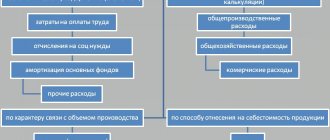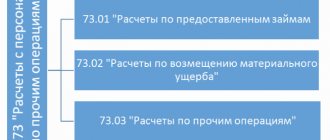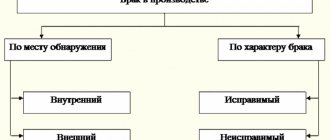What is account 70 used for in accounting?
Account 70 “settlements with personnel for wages” is used according to the Chart of Accounts to reflect on it all wage settlements for both employees carrying out activities under employment contracts, and under contracts for the provision of services with individuals.
This account accumulates information on salary calculation in all its components:
- salary payment;
- bonuses;
- additional payments;
- vacations;
- compensation;
- payment of benefits and financial assistance, etc.
With the help of this information, the administration can make the necessary decisions on labor costs. This account summarizes the salaries of employees in all departments of the company. On the other hand, depending on the corresponding account, it is possible to establish labor costs for each structural unit.
This reflects information about the existence of existing debts, both of the employee for overpaid wages, and of the enterprise itself for wages that were not paid on time.
Attention! Account 70 also reflects settlements with the founders, who are also employees of the company, for dividends accrued to them.
General description of the balance sheet for account 70
This register groups information about balances at the beginning and end of the period, turnover for the reporting period in account 70 “Settlements with personnel for wages”. Data in the statement must be disclosed for each employee. The procedure for recording transactions on account 70 is regulated by Section VI of the Order of the Ministry of Finance of the Russian Federation “On approval of the chart of accounts for accounting…” dated October 31, 2000 No. 94n:
| Transactions reflected in the debit of the account. 70: | Operations reflected on the credit account. 70: |
|
|
*The “Salary Deposit” operation is becoming less and less common these days. Its meaning is to close the payroll compiled for a group of employees when paying wages in cash. Since currently most organizations use non-cash forms of payment to pay wages, the formation of a unified payroll is losing relevance.
Moreover, as of November 30, 2020, the Bank of Russia’s directive No. 5587-U dated October 5, 2020 eliminated the rule about reflecting in the payroll the deposit of wages that were not paid on time.
ConsultantPlus experts told us what other innovations in the procedure for recording cash transactions came into effect on November 30, 2020. Get trial access to the K+ system and go to the review material for free. In K+ you can also check whether you are processing salary payments correctly. If you do not have access to the K+ system, sign up for a trial demo access and study the material for free.
The balance can be anything: active, passive and active-passive. Basically the balance of the account. 70 can be passive, this is due to the fact that wages are calculated on the last day of the reporting (worked) month, and are issued to the employee in the subsequent month. An active or active-passive balance can be when an excessive payment of wages to an employee exceeds their accrual, for example, when an erroneous transfer is made to a salary account.
An example of filling out a statement of accounts. 70 you can look at on our website. follow the link below.
Account characteristics
To record payroll calculations, account 70 is used. When asked which account 70 is active or passive, you can clearly answer that it is an active-passive account.
Depending on the situation, it can have two balances at once. The debit balance reflects the debt of persons working at the enterprise for the wages paid to them by the enterprise. The loan balance, on the contrary, reflects the employer’s debt to the employees working in the company.
When determining the final account balance, it matters which side the balance is on. If by debit, then the debit turnover reflects the increase in debt, and the credit turnover reflects its repayment.
The opening balance is added to the debit turnover, after which the resulting result must be compared with the credit balance. If the final value of the difference with the loan turnover turns out to be positive, then the final balance is a debit.
When the initial balance of account 70 is on credit, then the increase in debt is reflected on the credit side, and its repayment on the debit side. If the difference between the amount of the opening balance and the turnover on the credit account with the debit turnover is positive, then the ending balance is in credit. Otherwise, at the end of the period, a debit balance of account 70 is obtained.
Attention! The turnover sheet for account 70 can reflect two balances at once. This is due to the fact that subaccounts within it can be either debit or credit, and the synthetic account has a folded double balance.
In the balance sheet, account 70 balances are reflected as follows:
- In the asset as part of current assets on line 1230 as accounts receivable.
- In liabilities as part of short-term liabilities on line 1520 as accounts payable.
You might be interested in:
Chart of accounts for 2021 with explanations and entries
Practical use of the balance sheet for account 70
In the balance sheet, the credit balance from the account statement. 70 as of the reporting date is reflected in the “Short-term liabilities” section in the line “Accounts payable” (clause 20 of PBU 4/99).
If there is an active-passive balance on the account. 70 data from the register is reflected in both the asset and liability of the balance sheet. Reducing assets and liabilities between themselves by offset is prohibited (clause 34 of PBU 4/99). At the same time, the active balance on the account. 70 is reflected in section II “Current assets” in the “Accounts receivable” line of the balance sheet.
It must be remembered that if the report indicators are of a significant level, then the data on them must be reflected separately.
Our article “What requirements should accounting reporting satisfy?” will help you understand the definition of the concept of “materiality level.”
In this case, you need to highlight a separate line in the balance sheet:
- in the liabilities side of the balance sheet in the “Short-term liabilities” section, the line “Debt to the organization’s personnel”
or
- in the balance sheet asset in the “Current assets” section, the line “Advances issued to employees.”
There are some difficulties in the practical application of the balance sheet for account 70. Thus, detailed information about the nature of settlement transactions with employees may be useful for interested users, such as:
- type of accrual;
- source of financing (cost, net profit, reserve, etc.);
- method of repaying debt to an employee (cash payment, deduction based on a writ of execution, deduction of personal income tax, use of non-monetary forms of payment, etc.).
SALT on account 70 does not provide users with such information. It only answers questions such as: “How much was accrued and issued to the employee? What is the balance of mutual settlements with him? To obtain more complete information on account 70, it is advisable to use other registers: payroll, summary of accrued wages, account turnover, etc.
More details about the payroll statement are described in the material “Unified Form No. T-49 - Form and Sample”.
Is it possible to pay part of the salary in kind on a time frame that is different from the time period for payment of the daily salary? The answer to this question was explained by the State Counselor of Justice of the Russian Federation, 2nd class of the State Labor Inspectorate in the Perm Territory, Yu. A. Dotsenko. Study the official’s point of view by getting trial access to the ConsultantPlus system for free.
What subaccounts are used?
Analytical accounting for account 70 is built for each employee separately. As a rule, information on people is combined into higher subaccounts, which are created for each department in the company.
The Chart of Accounts does not establish subaccounts recommended for opening, therefore it is customary to independently create subaccounts of a higher order with the following grouping:
- Settlements with staff members.
- Calculations under contract agreements.
- Settlements with part-time workers.
- Settlements with disabled personnel.
Attention! The enterprise must approve the Working Chart of Accounts when putting the Accounting Policy into effect.
Results
SALT for account 70 is one of the possible registers for grouping data on settlements with employees. The data from this report is used to generate financial statements. Balance sheet according to the account. 70 provides information on accrued and paid wages and balances as of reporting dates for each employee of the organization. In order to obtain more detailed information on settlements with personnel, it is necessary to use other forms of accounting registers.
Sources: Order of the Ministry of Finance of the Russian Federation dated October 31, 2000 N 94n
You can find more complete information on the topic in ConsultantPlus. Free trial access to the system for 2 days.
Corresponds with accounts
Account 70 can correspond with the following accounts:
From the debit of account 70 to the credit of accounts:
- Account 50 - when paying wages in cash from the cash register;
- Account 51 – when paying wages by transfer from a current account;
- Account 52 – when paying wages by transfer from a foreign currency account;
- Account 55 – when paying wages by transfer from a special account;
- Account 68 - regarding tax withholding from wages;
- Account 69 - when withholding funds not covered by the social insurance fund (for example, when paying for a voucher);
- Account 71 - when withholding unpaid accountable amounts;
- Account 73 - when withholding funds in favor of the company (for example, when covering damage or defects);
- Account 76 - when depositing unpaid wages, or deductions under writs of execution;
- Account 79 - for settlements between the parent company and the branch;
- Account 94 - for a one-time recovery of the deficiency from the guilty person.
According to the credit of the account, it corresponds with the debit of the following accounts:
- Account 08 - regarding the calculation of wages to employees involved in the creation or preparation for operation of a non-current asset;
- Account 20 - when calculating wages to the main employees of the workshop;
- Account 23 – when calculating wages for employees of the auxiliary workshop;
- Account 25 – when calculating salaries for managerial or technical personnel;
- Account 26 - when calculating salaries for administrative staff;
- Account 28 - when calculating wages for employees who are constantly engaged in correcting defects;
- Account 29 – when calculating wages to employees of service farms;
- Account 44 - when calculating wages for employees engaged in trade;
- Account 69 - when calculating payments made from social funds;
- Account 76 - when calculating payments from third parties in favor of a specific employee;
- Account 79 – for settlements between the parent company and the branch;
- Account 84 - when accruing income based on the results of activities to the founders, members of the company, etc.;
- Account 91 - when calculating wages to employees who are not engaged in their main activities;
- Account 96 - in case of accrual of payments made at the expense of a previously created reserve;
- Account 97 - when calculating payments that will actually be taken into account in the following periods;
- Account 99 - when calculating payment for work to eliminate the consequences of force majeure.
You might be interested in:
An employee took a taxi on a business trip - is it possible to deduct these expenses?
What is reflected in debit and credit
The debit of account 70 shows:
- Amounts of paid salaries, bonuses, benefits, and other cash payments to the employee;
- Amounts of accrued taxes, fees, deductions under writs of execution, etc.
- Amounts of accrued but not paid wages on time.
The account credit reflects:
- The amount of salary that the employee earned for the specified period;
- Amounts of earnings that were accrued from reserves;
- Amounts of accrued benefits - sick leave, maternity leave, etc., paid from social insurance funds;
- Amounts of income from participation in the capital of the organization.
What does the debit of account 70 show: postings
On the debit side of account 70 the following are recorded:
- Withholding personal income tax from wages.
The posting used here is: Dt 70 Kt 68 (13% (or 30% if the physicist is a non-resident) of the amount reflected in the accrued wages). The amount of salary payable on account 70 decreases, because the employer, being a tax agent, withholds the calculated personal income tax, increasing the credit balance on the account. 68 (personal income tax subaccount).
The subsequent transfer of personal income tax to the budget is reflected by posting Dt 68 Kt 51. Other deductions from wages are also possible. For example, alimony under a writ of execution:
- Dt 70 Kt 76 - alimony withheld;
- Dt 76 Kt 51 - alimony is transferred to the recipient.
- Payment of wages.
Posting Dt 70 Kt 51 (if the salary is issued to the current account) or Dt 70 Kt 50 (if the salary is issued in cash from the cash register). The amount to be issued is the one that remains on the credit of account 70 (credit balance), i.e. minus personal income tax (and other deductions, if any).
In practice, debit and credit entries can be visualized using the account balance sheet. Let's consider its specifics .
Examples of accounting entries for an account
All transactions listed below in 1c are generated automatically by completing the necessary documents.
Payroll
| Debit | Credit | Description |
| 08 | 70 | Salaries accrued to employees involved in preparing non-current assets for operation |
| 20 | 70 | Salaries accrued to employees of the main workshop |
| 23 | 70 | Salaries accrued to employees of the auxiliary workshop |
| 25 | 70 | Salaries accrued to general production employees |
| 26 | 70 | Administrative staff salaries accrued |
| 29 | 70 | Salaries accrued to maintenance department employees |
| 44 | 70 | Salaries accrued to employees who sell products |
| 97 | 70 | Vacation accrued for the future period |
Salary payments
| Debit | Credit | Description |
| 70 | 50 | Payment was made in cash from the cash register |
| 70 | 51 | Payment was made by transfer from the current account |
| 70 | 55 | Payment was made by transfer from a special account |
Accounting for payroll in the accounting of the parent company for the branch
| Debit | Credit | Description |
| 20 | 79/2 | The salaries of the employees of the main workshop of the branch were calculated |
| 26 | 79/2 | The salaries of the administrative staff of the branch were calculated |
| 79/2 | 51 | Funds transferred to pay salaries |
Payroll calculation in the branch
| Debit | Credit | Description |
| 20 | 70 | The salaries of the employees of the main workshop were calculated |
| 26 | 70 | Administrative employees were accrued |
| 79/2 | 20 | The calculation of wages for workshop employees is attributed to settlements with the parent company |
| 79/2 | 26 | Payroll for administrative personnel is included in settlements with the parent company |
| 51 | 79/2 | Received funds from the parent company to pay salaries |
| 50 | 51 | Funds received at the cash desk |
| 70 | 50 | Salaries were issued in cash from the cash register |









